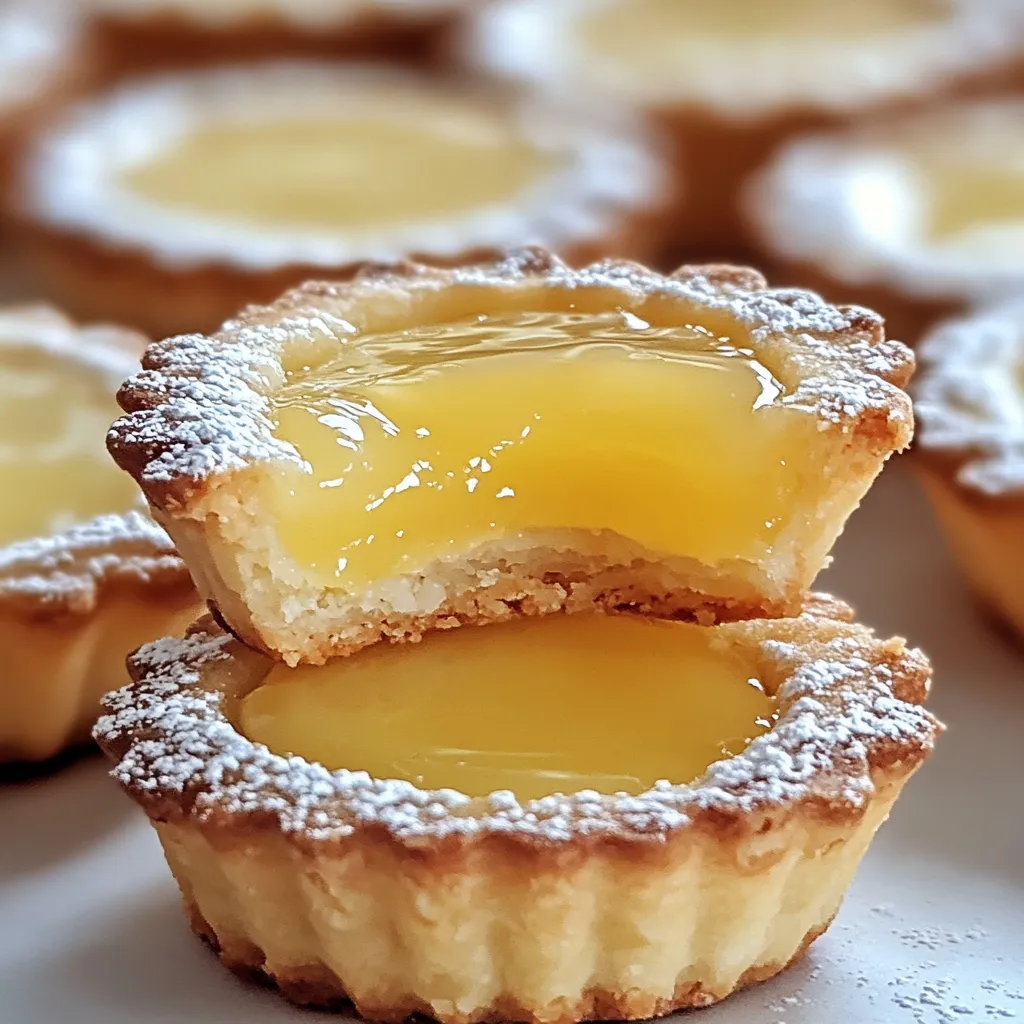 Pin it
Pin it
Lemon bar cookie cups ingeniously reimagine classic lemon bars into elegant, individual servings that deliver perfect buttery-crisp bases crowned with silky, sunshine-bright citrus filling in every perfect bite. These charming treats brilliantly solve the messiness of traditional lemon bars while intensifying their appeal through precise filling-to-crust ratios that maximize flavor in each mouthful. I created these for my daughter's garden party when I needed a sophisticated yet portable dessert that wouldn't require utensils, and they've since become my most requested contribution to spring and summer gatherings.
The first time I served these at a Mother's Day brunch, my notoriously critical mother-in-law requested the recipe before she'd even finished her first cup. What delights me most about this dessert is how it transforms a beloved classic into something fresh and unexpected while actually simplifying both preparation and serving. Even friends who claim they "don't like lemon desserts" find themselves reaching for seconds.
Citrus Essentials
- Fresh lemons: Provide both juice and zest for authentic flavor; Meyer lemons offer delicate sweetness when available
- Quality butter: Creates the shortbread-like base; European-style with higher butterfat produces superior texture
- All-purpose flour: Forms the structure of the cookie cups; unbleached varieties offer better flavor
- Granulated sugar: Balances the tartness of lemon while helping the filling set properly
- Large eggs: Provide structure and richness to the filling; room temperature eggs incorporate more smoothly
- Powdered sugar: Creates the classic finishing touch that enhances both appearance and sweetness
- Baking powder: A small amount provides just enough lift to prevent the filling from becoming too dense
- Mini muffin tin: Creates the perfect single-serving vessels; non-stick varieties simplify removal
I learned an important lesson about lemon zest during my first attempt at these cups. Using a box grater created harsh, bitter zest that overwhelmed the delicate filling. I now exclusively use a microplane to remove just the fragrant yellow layer while leaving behind the bitter white pith. This simple tool change transformed the bright flavor profile of the filling, allowing the true lemon essence to shine through without bitterness.
Citrus Success
- Prepare The Perfect Base:
- Begin with room temperature butter for the cookie cup base—cold butter won't incorporate properly while melted butter alters the texture completely. Beat the butter and sugar together until light and fluffy, about 2-3 minutes with an electric mixer, creating air pockets that prevent a dense, heavy base. Add flour gradually, mixing just until combined to avoid developing gluten, which would make the cups tough rather than tender. The resulting mixture should resemble moist sand that holds together when pressed.
- Create Uniform Cups:
- Using a measuring tablespoon ensures consistent amounts of dough in each muffin cup. Press the mixture firmly against the bottom and up the sides, creating a well-defined cup with walls approximately 1/4-inch thick. A shot glass or small spice bottle wrapped in plastic wrap makes an excellent tool for pressing the dough evenly into mini muffin cups. Create a slight lip around the top edge to contain the filling during baking. Pre-baking these shells for 8-10 minutes sets their structure before adding the wet filling.
- Craft Bright Filling:
- The filling begins with fresh lemon juice—bottled varieties simply can't compare in flavor brightness. When measuring lemon zest, pack it loosely rather than compressing it to avoid overwhelming bitterness. Whisking eggs until slightly frothy before adding sugar and lemon creates a smoother texture. A pinch of salt heightens the lemon flavor while a small amount of baking powder provides just enough lift to prevent a rubbery texture. Strain the filling through a fine-mesh sieve for the silkiest possible result.
- Master The Bake:
- Fill each pre-baked cup almost to the top—the filling will puff slightly during baking but settle as it cools. Bake until the centers are just set with a slight wobble, about 12-15 minutes. Overbaking causes the filling to crack and become rubbery rather than lusciously smooth. Allow the cups to cool completely in the tin before attempting removal. Once cooled, gently twist each cup to release it rather than prying, which can damage the delicate edges.
- Perfect The Finish:
- Just before serving, dust the tops with powdered sugar through a fine-mesh sieve for the most professional appearance. This final touch not only adds sweetness but also creates the classic lemon bar look that signals the tangy treat awaiting beneath. For special occasions, add tiny candied lemon peel curls or edible flower petals alongside the powdered sugar for elevated presentation.
 Pin it
Pin it
During a summer gathering, my friend attempted this recipe but complained that her cookie cups stuck terribly to the pan. After troubleshooting together, we discovered she had used cooking spray instead of thoroughly greasing each cup with butter. I've since learned that the butter coating not only prevents sticking but also adds a lovely flavor to the outer cookie edge that cooking spray simply can't provide. Sometimes these small technique differences make dramatic differences in the final result.
Serving Suggestions
These versatile treats shine in various settings throughout the year. For spring brunches, arrange them on tiered stands interspersed with fresh berries and mint sprigs. During summer gatherings, serve alongside a limoncello whipped cream for dipping. At bridal or baby showers, place individual cups in decorative paper liners on vintage serving platters. For holiday dessert tables, drizzle half of each cup with white chocolate and sprinkle with festive colored sugar for added elegance.
Creative Variations
While the classic version delights purists, this adaptable recipe welcomes thoughtful modifications. Create citrus medley cups by combining equal parts lemon, lime, and orange juices and zests. For a sophisticated touch, infuse the sugar with lavender by processing dried culinary lavender with granulated sugar before mixing the filling. Add a hidden surprise with a small fresh raspberry or blackberry pressed into the filling before baking. For tropical flair, substitute pineapple juice and coconut extract for a piña colada inspired variation.
Storage Strategy
These lemon bar cups maintain their quality remarkably well when properly stored. Keep them in a single layer in an airtight container at room temperature for up to two days or refrigerated for up to a week. The powdered sugar topping may absorb moisture during storage, so refresh it just before serving for the best presentation. For make-ahead convenience, freeze the unfilled baked cookie cups for up to a month, then thaw at room temperature before filling and baking according to the recipe.
I've been perfecting these lemon bar cookie cups for over five years, making subtle adjustments with each batch. What began as a practical solution to serving challenges has evolved into one of my signature desserts—the one friends specifically request for gatherings. Last Easter, a friend's grandmother asked for the recipe, saying they reminded her of the lemon bars she made in her youth "but even better." The beauty of this recipe lies in its ability to honor tradition while improving upon it, proving that sometimes the most beloved recipes are those that respect the classics while thoughtfully reimagining them.
 Pin it
Pin it
Frequently Asked Questions
- → What ingredients do I need?
- You need unsalted butter, granulated sugar, eggs, vanilla extract, all-purpose flour, baking powder, salt, lemon juice, lemon zest, and optional powdered sugar for dusting.
- → How long does it take to prepare?
- Prep time is 20 minutes, and total time is 32 minutes.
- → Can I use a different type of citrus?
- Yes, you can use lime or orange juice for a different flavor.
- → How should I store leftovers?
- Store leftovers in an airtight container in the refrigerator for up to 5 days.
- → Can I make them ahead of time?
- Yes, you can make them ahead and store them in the refrigerator.
